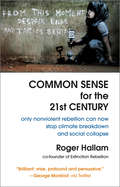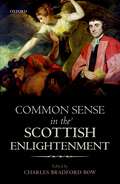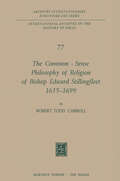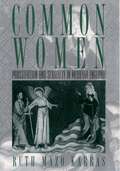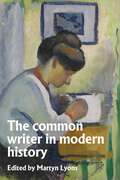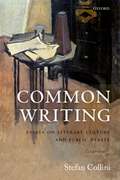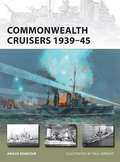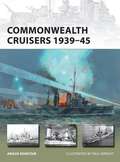- Table View
- List View
Common Sense About the Common Market: Germany and Britain in Post-War Europe (Routledge Revivals)
by E. StraussThe Common Market between France, Western Germany, Italy and the ‘Benelux’ counties was not merely a reshuffle of tariff rates and trade agreements, but a political mile-stone in post-war history. Originally published in 1958, this book surveys the pre-history of the Common Market from the German Zollverein to the abortive customs union with Austria in 1931 and traces its roots amongst the tangled post-war politics of occupied Germany, the Ruhr Authority and the Coal and Steel pool. The book provides a summary of post-war economic developments in Europe and examines the guiding principles of the famous Spaak Report, comparing it with the text of the Rome Treaty. Finally the book deals with the challenge of the new developments to Great Britain.
Common Sense and a Little Fire, Second Edition: Women and Working-Class Politics in the United States, 1900-1965 (Gender and American Culture)
by Annelise OrleckOver twenty years after its initial publication, Annelise Orleck's Common Sense and a Little Fire continues to resonate with its harrowing story of activism, labor, and women's history. Orleck traces the personal and public lives of four immigrant women activists who left a lasting imprint on American politics. Though they have rarely made more than cameo appearances in previous histories, Rose Schneiderman, Fannia Cohn, Clara Lemlich Shavelson, and Pauline Newman played important roles in the emergence of organized labor, the New Deal welfare state, adult education, and the modern women's movement. Orleck takes her four subjects from turbulent, turn-of-the-century Eastern Europe to the radical ferment of New York's Lower East Side and the gaslit tenements where young workers studied together. Orleck paints a compelling picture of housewives' food and rent protests, of grim conditions in the garment shops, of factory-floor friendships that laid the basis for a mass uprising of young women garment workers, and of the impassioned rallies working women organized for suffrage. Featuring a new preface by the author, this new edition reasserts itself as a pivotal text in twentieth-century labor history.
Common Sense for the 21st Century: Only Nonviolent Rebellion Can Now Stop Climate Breakdown and Social Collapse
by Roger Hallam“Brilliant, wise, profound and persuasive. Common Sense for the 21st Century will come to be recognized as a classic of political theory.”—George Monbiot, via Twitter An urgent, essential, and practical call to action from a cofounder of Extinction Rebellion What can we all do to avert catastrophe and avoid extinction? Roger Hallam has answers. In Common Sense for the 21st Century, Roger Hallam, cofounder of Extinction Rebellion, outlines how movements around the world need to come together now to start doing what works: engaging in mass civil disobedience to make real change happen. The book gives people the tools to understand not only why mass disruption, mass arrests, and mass sacrifice are necessary but also details how to carry out acts of civil disobedience effectively, respectfully and nonviolently. It bypasses contemporary political theory, and instead is inspired by Thomas Paine, the pragmatic 18th-century revolutionary whose pamphlet Common Sense sparked the American Revolution. Common Sense for the 21st Century urges us to confront the truth about climate change and argues forcefully that only a revolution of society and the state, similar to the turn that Paine urged the Americans to take into the political unknown, can save us now.
Common Sense in the Scottish Enlightenment (Mind Association Occasional Series)
by C. B. BowCommon sense philosophy was one of eighteenth-century Scotland's most original intellectual products. It developed as a viable alternative to modern philosophical scepticism, known as the 'Ideal Theory' or 'the way of ideas'. The nine specially written essays in this volume explore the philosophical and historical significance of common sense philosophy in the Scottish Enlightenment. Thomas Reid and David Hume feature prominently as influential authors of competing ideas in the history and philosophy of common sense. The contributors recover anticipations of Reid's version of common sense in seventeenth-century Scottish scholasticism; revaluate Reid's position in the realism versus sentimentalism dichotomy; shed new light on the nature of the 'constitution' in the anatomy of the mind; identify changes in the nature of sense perception throughout Reid's published and unpublished works; examine Reid on the non-theist implications of Hume's philosophy; show how 'polite' literature shaped James Beattie's version of common sense; reveal Hume's response to common sense philosophers; explore English criticisms of the Scottish 'school', and how Dugald Stewart's refashioning of common sense responded to a new age and the British reception of German Idealism. In recovering the ways in which Scottish common sense philosophy developed during the long eighteenth century, this volume takes an important step toward a more complete understanding of 'the Scottish philosophy' and British philosophy more broadly in the age of Enlightenment.
Common Sense in the Scottish Enlightenment (Mind Association Occasional Series)
Common sense philosophy was one of eighteenth-century Scotland's most original intellectual products. It developed as a viable alternative to modern philosophical scepticism, known as the 'Ideal Theory' or 'the way of ideas'. The nine specially written essays in this volume explore the philosophical and historical significance of common sense philosophy in the Scottish Enlightenment. Thomas Reid and David Hume feature prominently as influential authors of competing ideas in the history and philosophy of common sense. The contributors recover anticipations of Reid's version of common sense in seventeenth-century Scottish scholasticism; revaluate Reid's position in the realism versus sentimentalism dichotomy; shed new light on the nature of the 'constitution' in the anatomy of the mind; identify changes in the nature of sense perception throughout Reid's published and unpublished works; examine Reid on the non-theist implications of Hume's philosophy; show how 'polite' literature shaped James Beattie's version of common sense; reveal Hume's response to common sense philosophers; explore English criticisms of the Scottish 'school', and how Dugald Stewart's refashioning of common sense responded to a new age and the British reception of German Idealism. In recovering the ways in which Scottish common sense philosophy developed during the long eighteenth century, this volume takes an important step toward a more complete understanding of 'the Scottish philosophy' and British philosophy more broadly in the age of Enlightenment.
The Common-Sense Philosophy of Religion of Bishop Edward Stillingfleet 1635–1699 (International Archives of the History of Ideas Archives internationales d'histoire des idées #77)
by Robert Todd CarrollI. Reason and Religion "Si on soumet tout a la raison, notre religion n'aura rien de mysterieux et de surnaturel; si on choque les principes de la raison, notre religion sera absurde et ridicule",l In this passage from his Pensees Pascal summarizes what is perhaps the most basic problem for the defender of the reasonableness of Christianity: the necessity of upholding beliefs which Reason is incapable of judging, while at the same time claiming that those beliefs are reasonable. Pascal does not state the problem in precisely these terms regarding the limits of Reason, yet it seems clear that the dilemma he is indicating involves the question of the relation of religious beliefs to the compass of Reason. He does not, however-at least in the passage cited-indicate that the problem is a question of either/or: either Reason and no Religion, or Religion and Irrationality. Rather, he seems to be simply stating what he perceives to be a simple matter of fact. If Reason is allowed to be the judge of all Religion, then all Religion must abandon any elements that are either contrary to reason or cannot be shown to be in accord with Reason. On the other hand, if Reason is not allowed to judge Religion at all, then Religion will be absurd and ridiculous.
The Common Stream: Two Thousand Years Of The English Village
by Rowland ParkerThis is the story of a village in East Anglia, astride its common stream - a saga of continuity and change which stretches back two thousand years. Rowland Parker tells the story of those who lived and died in the village, cutting out the familiar but domineering clamour of kings, prelates, politicians and absentee landowners. But since the common man leaves comparatively little trace, it took thirteen years of detective work to piece together, combing through reports of archaeological excavations and manor court rolls, collecting stories at the pub and inspecting old wills and land tax returns. Although The Common Stream was created by one man interested in the history of his village of Foxton in Cambridgeshire, with it Rowland Parker succeeds in giving us, at last, the true story of the English, alive with their feuds and fun, their farms and families, their fights and fornications.
Common Understandings, Poetic Confusion: Playhouses and Playgoers in Elizabethan England
by William N. WestA new account of playgoing in Elizabethan England, in which audiences participated as much as performers. What if going to a play in Elizabethan England was more like attending a football match than a Broadway show—or playing in one? In Common Understandings, Poetic Confusion, William N. West proposes a new account of the kind of participatory entertainment expected by the actors and the audience during the careers of Shakespeare and his contemporaries. West finds surprising descriptions of these theatrical experiences in the figurative language of early modern players and playgoers—including understanding, confusion, occupation, eating, and fighting. Such words and ways of speaking are still in use today, but their earlier meanings, like that of theater itself, are subtly, importantly different from our own. Playing was not confined to the actors on the stage but filled the playhouse, embracing audiences and performers in collaborative experiences that did not belong to any one alone but to the assembled, various crowd. What emerged in playing was a kind of thinking and feeling distributed across persons and times that were otherwise distinct. Thrown apples, smashed bottles of beer, and lumbering bears—these and more gave verbal shape to the physical interactions between players and playgoers, creating circuits of exchange, production, and consumption.
Common Wealth, Common Good: The Politics of Virtue in Early Modern Poland-Lithuania (Oxford Historical Monographs)
by Benedict Wagner-RundellCommon Wealth, Common Good is a study of the political discourse of the Commonwealth of Poland-Lithuania in the late seventeenth and early eighteenth centuries. It argues that the Polish-Lithuanian political tradition was preoccupied during this period with moral concepts, in particular that of public virtue, understood as the subordination of private interests to the common good. Polish-Lithuanian politicians and commentators analysed their politics primarily in moral terms, arguing that the Commonwealth existed for the promotion of virtue, and depended for its survival upon on the retention of virtue among rulers and citizens. They analysed the acute political dysfunction that the Commonwealth experienced from the late seventeenth century as the result of corruption in the body politic. Proposals for reform of the Commonwealth's government aimed at reversing this corruption and restoring virtuous government in the service of the common good. Benedict Wagner-Rundell analyses the most important political treatises, including reform proposals, of the late seventeenth and early eighteenth century, to demonstrate how virtue was central to contemporaries' understanding of the Commonwealth and its situation. He also argues that a concern with promoting virtue drove the development of local government during this period, and animated efforts for reform of the Commonwealth at the Sejm (Parliament) of 1712-13, and during the General Confederation of Tarnogród of 1715-17, a mass uprising by the Polish-Lithuanian nobility against King Augustus II. Placing the subject in international context, Common Wealth, Common Good argues that the Polish-Lithuanian political tradition's continuing preoccupation with virtue set it apart from republican traditions elsewhere in early-modern Europe and North America, where thinkers were beginning to consider whether self-interest could be harnessed as a positive political force. The Polish-Lithuanian tradition's failure to match such developments elsewhere in Europe arguably demonstrates its backwardness: however, its emphasis on the need for political systems to be underpinned by shared values still has great relevance today.
Common Women: Prostitution and Sexuality in Medieval England (Studies in the History of Sexuality)
by Ruth Mazo KarrasThrough a sensitive use of a wide variety of imaginative and didactic texts, Ruth Karras shows that while prostitutes as individuals were marginalized within medieval culture, prostitution as an institution was central to the medieval understanding of what it meant to be a woman. This important work will be of interest to scholars and students of history, women's studies, and the history of sexuality.
Common Women: Prostitution and Sexuality in Medieval England (Studies in the History of Sexuality)
by Ruth Mazo KarrasThrough a sensitive use of a wide variety of imaginative and didactic texts, Ruth Karras shows that while prostitutes as individuals were marginalized within medieval culture, prostitution as an institution was central to the medieval understanding of what it meant to be a woman. This important work will be of interest to scholars and students of history, women's studies, and the history of sexuality.
The common writer in modern history
by Martyn LyonsThis book underlines the importance of writing for the subordinate classes, and the variety of uses to which it was put. In eleven new studies by thirteen leading historians of scribal culture, it foregrounds the ‘common writer’ and contributes to a ‘New History from Below’. The book presents pauper letters, ego-documents, life-writing of various kinds, soldiers’ and emigrants’ correspondence, handwritten newspapers and graffiti in streets and prisons, analysing the major genres of ‘ordinary writings’. The studies draw on different disciplines, including cultural history, sociology and ethnography, folklore studies, palaeography and socio-historical linguistics. They range from the early modern Hispanic Empire to twentieth-century Australia, including studies of modern Britain, Iceland, Finland, Italy, Germany, South Africa and the USA. The book demonstrates the importance of studying manuscript culture to give a voice, a presence and dignity to the ordinary protagonists of history.
The common writer in modern history
by Martyn LyonsThis book underlines the importance of writing for the subordinate classes, and the variety of uses to which it was put. In eleven new studies by thirteen leading historians of scribal culture, it foregrounds the ‘common writer’ and contributes to a ‘New History from Below’. The book presents pauper letters, ego-documents, life-writing of various kinds, soldiers’ and emigrants’ correspondence, handwritten newspapers and graffiti in streets and prisons, analysing the major genres of ‘ordinary writings’. The studies draw on different disciplines, including cultural history, sociology and ethnography, folklore studies, palaeography and socio-historical linguistics. They range from the early modern Hispanic Empire to twentieth-century Australia, including studies of modern Britain, Iceland, Finland, Italy, Germany, South Africa and the USA. The book demonstrates the importance of studying manuscript culture to give a voice, a presence and dignity to the ordinary protagonists of history.
Common Writing: Essays on Literary Culture and Public Debate
by Stefan ColliniIn a series of penetrating and attractively readable essays, Stefan Collini explores aspects of the literary and intellectual culture of Britain from the early twentieth century to the present. Common Writing focuses chiefly on writers, critics, historians, and journalists who occupied wider public roles as cultural commentators or intellectuals, as well as on the periodicals and other genres through which they attempted to reach such audiences. Among the figures discussed are T.S. Eliot, Graham Greene, J.B. Priestley, C.S. Lewis, Kingsley Amis, Nikolaus Pevsner, Hugh Trevor-Roper, Christopher Hitchens, and Michael Ignatieff. The essays explore the variety of such figures' writings - something that can get overlooked or forgotten when they are treated exclusively in terms of their contribution to one established or professional category such as 'novelist' or 'historian' - while capturing their distinctive writing voices and those indirect or implicit ways in which they position or reveal themselves in relation to specific readerships, disputes, and traditions. These essays engage with recent biographies, collections of letters, and new editions of classic works, thereby making some of the fruits of recent scholarly research available to a wider audience. Collini has been acclaimed as one of the most brilliant essayists of our time, and this collection shows him at his subtle, perceptive, and trenchant best. Common Writing will appeal to (and delight) readers interested in literature, history, and contemporary cultural debate.
Common Writing: Essays on Literary Culture and Public Debate
by Stefan ColliniIn a series of penetrating and attractively readable essays, Stefan Collini explores aspects of the literary and intellectual culture of Britain from the early twentieth century to the present. Common Writing focuses chiefly on writers, critics, historians, and journalists who occupied wider public roles as cultural commentators or intellectuals, as well as on the periodicals and other genres through which they attempted to reach such audiences. Among the figures discussed are T.S. Eliot, Graham Greene, J.B. Priestley, C.S. Lewis, Kingsley Amis, Nikolaus Pevsner, Hugh Trevor-Roper, Christopher Hitchens, and Michael Ignatieff. The essays explore the variety of such figures' writings - something that can get overlooked or forgotten when they are treated exclusively in terms of their contribution to one established or professional category such as 'novelist' or 'historian' - while capturing their distinctive writing voices and those indirect or implicit ways in which they position or reveal themselves in relation to specific readerships, disputes, and traditions. These essays engage with recent biographies, collections of letters, and new editions of classic works, thereby making some of the fruits of recent scholarly research available to a wider audience. Collini has been acclaimed as one of the most brilliant essayists of our time, and this collection shows him at his subtle, perceptive, and trenchant best. Common Writing will appeal to (and delight) readers interested in literature, history, and contemporary cultural debate.
A Commonplace Killing
by Sian BusbyOn a damp July morning in 1946, two schoolboys find a woman"s body in a bomb site in north London. In this gripping murder story, Sian Busby gradually peels away the veneer of stoicism and respectability to reveal the dark truths at the heart of postwar austerity Britain.
Commonplace Reading and Writing in Early Modern England and Beyond (Material Readings in Early Modern Culture)
by Hao TianhuApproaching from bibliographical, literary, cultural, and intercultural perspectives, this book establishes the importance of Hesperides, or the Muses’ Garden, a largely unexplored manuscript commonplace book to early modern English literature and culture in general. Hesperides, or the Muses’ Garden is a seventeenth-century manuscript commonplace book known primarily for its Shakespearean connections, which extracts works by dozens of early modern English authors, including Shakespeare, Bacon, Ben Jonson, and Milton. This book sheds light on the broader significance of Hesperides that refashions our full knowledge of early modern authorship and plagiarism, composition, reading practice, and canon formation. Following two introductory chapters are three topical chapters, which respectively discuss plagiarism and early modern English writing, early modern English reading practice, and early modern English canon formation. The final chapter further expands the field to ancient China, comparing commonplace books with Chinese leishu, exploring Matteo Ricci’s cross-cultural commonplace writing, and re-reading Shakespeare’s sonnets in light of Ricci’s On Friendship. The solid book will serve as a must read for scholars and students of early modern English literature, manuscript study, commonplace books, history of the book, and intercultural study.
Commonplace Reading and Writing in Early Modern England and Beyond (Material Readings in Early Modern Culture)
by Hao TianhuApproaching from bibliographical, literary, cultural, and intercultural perspectives, this book establishes the importance of Hesperides, or the Muses’ Garden, a largely unexplored manuscript commonplace book to early modern English literature and culture in general. Hesperides, or the Muses’ Garden is a seventeenth-century manuscript commonplace book known primarily for its Shakespearean connections, which extracts works by dozens of early modern English authors, including Shakespeare, Bacon, Ben Jonson, and Milton. This book sheds light on the broader significance of Hesperides that refashions our full knowledge of early modern authorship and plagiarism, composition, reading practice, and canon formation. Following two introductory chapters are three topical chapters, which respectively discuss plagiarism and early modern English writing, early modern English reading practice, and early modern English canon formation. The final chapter further expands the field to ancient China, comparing commonplace books with Chinese leishu, exploring Matteo Ricci’s cross-cultural commonplace writing, and re-reading Shakespeare’s sonnets in light of Ricci’s On Friendship. The solid book will serve as a must read for scholars and students of early modern English literature, manuscript study, commonplace books, history of the book, and intercultural study.
Commonplace Witnessing: Rhetorical Invention, Historical Remembrance, and Public Culture
by Bradford VivianCommonplace Witnessing examines how citizens, politicians, and civic institutions have adopted idioms of witnessing in recent decades to serve a variety of social, political, and moral ends. The book encourages us to continue expanding and diversifying our normative assumptions about which historical subjects bear witness and how they do so. Commonplace Witnessing presupposes that witnessing in modern public culture is a broad and inclusive rhetorical act; that many different types of historical subjects now think and speak of themselves as witnesses; and that the rhetoric of witnessing can be mundane, formulaic, or popular instead of rare and refined. This study builds upon previous literary, philosophical, psychoanalytic, and theological studies of its subject matter in order to analyze witnessing, instead, as a commonplace form of communication and as a prevalent mode of influence regarding the putative realities and lessons of historical injustice or tragedy. It thus weighs both the uses and disadvantages of witnessing as an ordinary feature of modern public life.
Commonplace Witnessing: Rhetorical Invention, Historical Remembrance, and Public Culture
by Bradford VivianCommonplace Witnessing examines how citizens, politicians, and civic institutions have adopted idioms of witnessing in recent decades to serve a variety of social, political, and moral ends. The book encourages us to continue expanding and diversifying our normative assumptions about which historical subjects bear witness and how they do so. Commonplace Witnessing presupposes that witnessing in modern public culture is a broad and inclusive rhetorical act; that many different types of historical subjects now think and speak of themselves as witnesses; and that the rhetoric of witnessing can be mundane, formulaic, or popular instead of rare and refined. This study builds upon previous literary, philosophical, psychoanalytic, and theological studies of its subject matter in order to analyze witnessing, instead, as a commonplace form of communication and as a prevalent mode of influence regarding the putative realities and lessons of historical injustice or tragedy. It thus weighs both the uses and disadvantages of witnessing as an ordinary feature of modern public life.
Commonwealth and the English Reformation: Protestantism and the Politics of Religious Change in the Gloucester Vale, 1483–1560 (St Andrews Studies in Reformation History)
by Ben LoweWhilst much recent research has dealt with the popular response to the religious change ushered in during the mid-Tudor period, this book focuses not just on the response to broad liturgical and doctrinal change, but also looks at how theological and reform messages could be utilized among local leaders and civic elites. It is this cohort that has often been neglected in previous efforts to ascertain the often elusive position of the common woman or man. Using the Vale of Gloucester as a case study, the book refocuses attention onto the concept of "commonwealth" and links it to a gradual, but long-standing dissatisfaction with local religious houses. It shows how monasteries, endowed initially out of the charitable impulses of elites, increasingly came to depend on lay stewards to remain viable. During the economic downturn of the mid-Tudor period, when urban and landed elites refocused their attention on restoring the commonwealth which they believed had broken down, they increasingly viewed the charity offered by religious houses as insufficient to meet the local needs. In such a climate the Protestant social gospel seemed to provide a valid alternative to which many people gravitated. Holding to scrutiny the revisionist revolution of the past twenty years, the book reopens debate and challenges conventional thinking about the ways the traditional church lost influence in the late middle ages, positing the idea that the problems with the religious houses were not just the creation of the reformers but had rather a long history. In so doing it offers a more complete picture of reform that goes beyond head-counting by looking at the political relationships and how they were affected by religious ideas to bring about change.
Commonwealth and the English Reformation: Protestantism and the Politics of Religious Change in the Gloucester Vale, 1483–1560 (St Andrews Studies in Reformation History)
by Ben LoweWhilst much recent research has dealt with the popular response to the religious change ushered in during the mid-Tudor period, this book focuses not just on the response to broad liturgical and doctrinal change, but also looks at how theological and reform messages could be utilized among local leaders and civic elites. It is this cohort that has often been neglected in previous efforts to ascertain the often elusive position of the common woman or man. Using the Vale of Gloucester as a case study, the book refocuses attention onto the concept of "commonwealth" and links it to a gradual, but long-standing dissatisfaction with local religious houses. It shows how monasteries, endowed initially out of the charitable impulses of elites, increasingly came to depend on lay stewards to remain viable. During the economic downturn of the mid-Tudor period, when urban and landed elites refocused their attention on restoring the commonwealth which they believed had broken down, they increasingly viewed the charity offered by religious houses as insufficient to meet the local needs. In such a climate the Protestant social gospel seemed to provide a valid alternative to which many people gravitated. Holding to scrutiny the revisionist revolution of the past twenty years, the book reopens debate and challenges conventional thinking about the ways the traditional church lost influence in the late middle ages, positing the idea that the problems with the religious houses were not just the creation of the reformers but had rather a long history. In so doing it offers a more complete picture of reform that goes beyond head-counting by looking at the political relationships and how they were affected by religious ideas to bring about change.
Commonwealth Cruisers 1939–45 (New Vanguard #226)
by Angus Konstam Mr Paul WrightIn the early 20th century Britain's largest colonies established their own small naval presence, and their ships fought alongside the Royal Navy during World War I. These fleets were expanded during the inter-war years, and in 1939 the Royal Australian Navy, the Royal Canadian Navy and the Royal New Zealand Navy willingly joined the fight on behalf of the British Commonwealth. For the most part these small navies consisted of a few cruisers and destroyers, designed to protect territorial waters and local sea lanes. However, these warships and their crews soon found themselves involved in a global war, and consequently were called upon to fight wherever they were needed, against the Germans, the Italians and the Japanese. This book tells the story of these small cruiser forces, and the men who served the Allied cause so well during the long and brutal war at sea.
Commonwealth Cruisers 1939–45 (New Vanguard)
by Paul Wright Angus KonstamIn the early 20th century Britain's largest colonies established their own small naval presence, and their ships fought alongside the Royal Navy during World War I. These fleets were expanded during the inter-war years, and in 1939 the Royal Australian Navy, the Royal Canadian Navy and the Royal New Zealand Navy willingly joined the fight on behalf of the British Commonwealth. For the most part these small navies consisted of a few cruisers and destroyers, designed to protect territorial waters and local sea lanes. However, these warships and their crews soon found themselves involved in a global war, and consequently were called upon to fight wherever they were needed, against the Germans, the Italians and the Japanese. This book tells the story of these small cruiser forces, and the men who served the Allied cause so well during the long and brutal war at sea.


